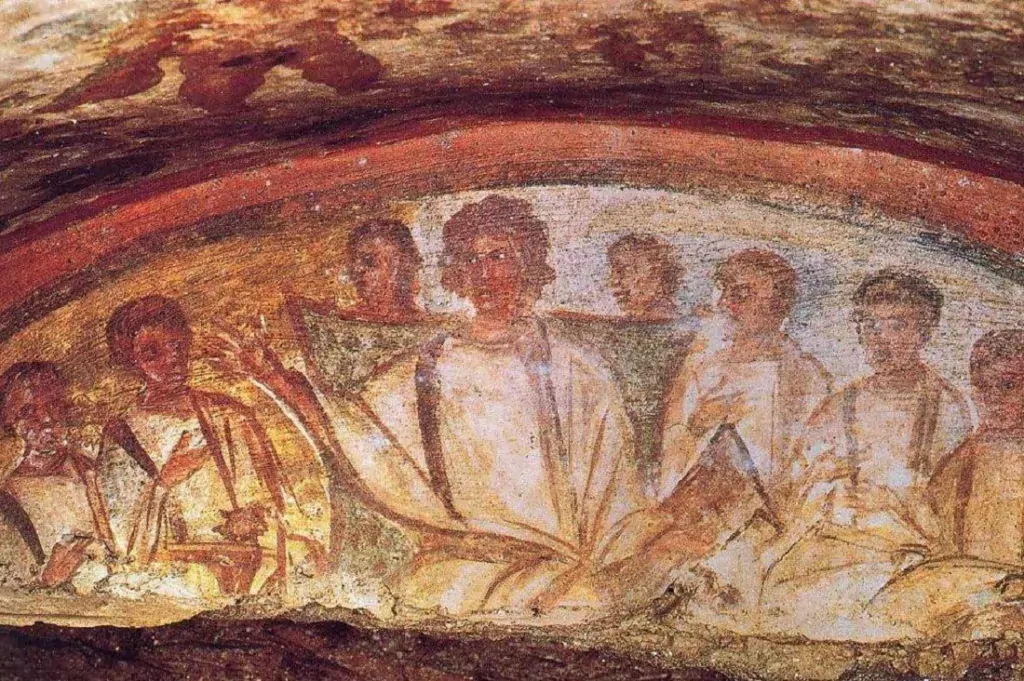Life of Christians in the early Church – Fr. Alexander Schmemann
Eastern Orthodox Phronema | Posted on |

What was the positive ideal of the Life of Christians in the early Church community? For the early Church, unity in love was the ultimate value; it was the supreme purpose of life that Christ Himself had revealed to men. The Church was the restoration of the unity that had been broken and torn asunder by sin; those who were baptized, who were living in union with Christ and sharing in His life through the breaking of bread, were reunited with God, and in God, they also found unity with one another.
This unity was demonstrated above all in the active love through which each Christian was conscious that he belonged to all the brethren, and conversely, that they all belonged to him. The unity of Christians with one another is now, alas, only symbolized by their communion in divine service; in the early Church the liturgy was the crowning point of real unity, a continual communion in everyday life; moreover, the liturgy was then unthinkable apart from that communion. In early Christian writings no other word is so often repeated as “brother,” and Christians of that age filled the idea of brotherhood with vital meaning, which showed clearly in their unity of thought: “And the multitude of them that believed were of one heart and of one soul . . .” (Acts 4:32).
Brotherhood also meant active mutual support among Christians “of all for all” — care that was both material and spiritual. “And all that believed were together, and had all things in common; and sold their possessions and goods, and parted them to all men, as every man had need” (Acts 2:44f.). The very smallness of the Christian community in Jerusalem made it possible to put the unity of life into practice in a radical way through sharing their property. This phenomenon, inaccurately described as “primitive Christian communism,” was not the product of any specifically Christian economic or social theory, but a manifestation of love. Its meaning lies not in the community of property as such, but in the evidence it gives us of the new life that manifested itself among them, entirely transforming the old.
In the Pauline epistles, we find the summons: “Every man according as he purposeth in his heart, so let him give” (II Cor. 9:7) — a remark that points to the survival of private property in other Christian communities. But the utter devotion of the Jerusalem community — the brotherhood of “beggars” as St. Paul called them — remains forever in the mind of Christendom as an ineffaceable example and legacy, the ideal of an authentic regeneration of all human relationships through love.
The early Church has often been described as indifferent to this world and as existing in a continual tense expectancy of the End. But the new life also involved a new attitude toward the world; since for Christians this love is not an internal affair of the Church, but, on the contrary, the essence of her witness in the world. “By this shall all men know that ye are my disciples if ye love one another” (John 13:35). If we read the New Testament with care we discover a complete doctrine concerning the world and how Christians should relate to it and live in it.
The Sermon on the Mount, the Beatitudes, and the figure of the merciful, succoring Christ are proclaimed to the world by the Church and will remain the world’s ideal even when men reject the Church. And when Christians have sought the basic standards by which to determine their relationship to the state, to the family, to work — indeed, to all aspects of human life — have they not always searched the epistles of St. Paul? The expectation of the End, the prayers for the coming of Christ — everything which it is now the fashion to call eschatological — cannot, without doing violence to historical truth, be divorced from this positive ideal.
The kingdom to come for which Christians pray is for them inseparable from judgment, and their judgment will reflect the precise extent to which they have embodied their faith in their own lives, i.e., in the world. “Inasmuch as ye have done it unto one of the least of these. . .” (Matt. 25:40). Through Christ the kingdom of God has entered human life in order to regenerate it.
Here, then, is the image of the Church bequeathed to us by the records of her earliest days. Does this mean that she had no failings or weaknesses then? Of course not. The author of Acts mentions many of them, and in the Pauline epistles, whole chapters will be devoted to exposing and scoring these sins. But as we begin the history of the Church, in which such sins and weaknesses will too often be painfully obvious, we also need to keep in mind that “icon of the Church” — that image and realization of the first experience of true life in the Church — to which Christians will always have recourse when they seek to cure their spiritual ailments and overcome their sins.
Fr. Alexander Schmemann
The Historical Road of Eastern Orthodoxy

Early Christian Life and Thought in Social Context: A Reader
Early Christian Life and Thought in Social Context fills a vacuum in current scholarship. While there exist a number of anthologies of sources for students of the New Testament and early Judaism, this book integrates concise explanatory comment on various aspects of the historical and social situation of the early Christians with substantial extracts from early Christian...
Leave a Reply